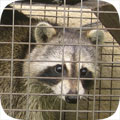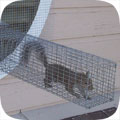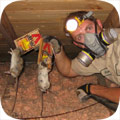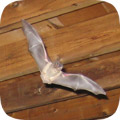- crockett@wildlifeanimalcontrol.com
Call 24/7 for a free quote:
936-657-1921
Crockett Wildlife Animal Control
Professional Wildlife Removal Company Servicing Crockett, TX
If you have a problem with wildlife in your Crockett home, your best option is to hire a company that specializes in Texas wildlife removal only. This is a specialty business, and regular pest control companies do not use the proper techniques to solve animal problems. I have spent many years reviewing Texas and Crockett, and I recommend the following:
Lufkin Wildlife Removal Professionals
Cell Phone: 936-657-1921
NOTE: If you have a dog or cat problem, call Houston County Animal Services: (936) 544-2021

Lufkin Wildlife Removal Professionals specializes primarily in removing animals from attics of homes and buildings - this includes squirrels in attics, raccoons, and rats or mice in homes. Texas also has a documented problem with
bats in buildings, and Lufkin Wildlife Removal Professionals is specially trained in bat removal. They also perform general wildlife trapping services, such as the capture and removal of skunks or opossums on the
property. Call 936-657-1921 to discuss your critter problem and schedule a same-day or next-day appointment. Click here to learn more about what prices we charge in 2020.
When hiring a company to solve your wild animal problem, you want these features:
- Specializes in wildlife removal, not pest control
- Fully Texas and Houston County licensed and insured
- Works 7 days per week (critters don't take weekends off)
- Performs full building inspections: enters and inspects attic
- Performs exclusion repairs, with guarantee against animal re-entry
- Offers cleanup of biohazardous wildlife waste
Lufkin Wildlife Removal Professionals is a full-service Crockett wildlife removal company. This is very different from a regular Crockett pest control company. The pest control companies spray poison to kill insects. This is not at all
similar to wildlife removal. Lufkin Wildlife Removal Professionals performs a full inspection of the home or property, and determines why the animal(s) are there, and if inside a building, how the animals got inside. All
animals (including rodents) are trapped and removed, or if possible, removed from the building using special exclusion devices. Once the animals are gone, preventative repairs are essential, and
cleanup is sometimes recommended.
 Crockett wildlife trapping - it's not as simple as it may seem. It's illegal in Texas to trap without a license. Trap type is very important and there are many different types, bait is somewhat relevant, trap placement
is vital, and there are dozens of small things that are very important to know.
Safety is a concern. Then once the animal is trapped, it must be removed and dealt with in the proper manner according to Texas law. We offer Crockett raccoon removal. Read more about how to get rid of raccoons.
Crockett wildlife trapping - it's not as simple as it may seem. It's illegal in Texas to trap without a license. Trap type is very important and there are many different types, bait is somewhat relevant, trap placement
is vital, and there are dozens of small things that are very important to know.
Safety is a concern. Then once the animal is trapped, it must be removed and dealt with in the proper manner according to Texas law. We offer Crockett raccoon removal. Read more about how to get rid of raccoons.
 Animals in attics - this is our specialty at Lufkin Wildlife Removal Professionals. Many types of animals like to live in attics. This includes squirrels, raccoons, rats, mice, bats, birds, and even possums. Critters like to go into attics for a safe place to live
and raise their young. Removing animals from attics is very complex work, partly because of the presence of baby animals. If you need Crockett squirrel removal, we can remove all the squirrels from your attic, and seal out any future ones. Read more about how to get rid of squirrels.
Animals in attics - this is our specialty at Lufkin Wildlife Removal Professionals. Many types of animals like to live in attics. This includes squirrels, raccoons, rats, mice, bats, birds, and even possums. Critters like to go into attics for a safe place to live
and raise their young. Removing animals from attics is very complex work, partly because of the presence of baby animals. If you need Crockett squirrel removal, we can remove all the squirrels from your attic, and seal out any future ones. Read more about how to get rid of squirrels.
 Rodent control must be done in a very specific way. First off, the most important thing is that all the openings that rats and mice can use to enter a house be sealed. Then all the rodents must be physically trapped and removed.
Never, ever use poison! Most Crockett exterminators will just use this lazy poison technique to kill rodents, and it causes more harm than good - dead stinky rats, and it doesn't solve the problem. Call us for correct Crockett rat removal. Read more about how to get rid of rats.
Rodent control must be done in a very specific way. First off, the most important thing is that all the openings that rats and mice can use to enter a house be sealed. Then all the rodents must be physically trapped and removed.
Never, ever use poison! Most Crockett exterminators will just use this lazy poison technique to kill rodents, and it causes more harm than good - dead stinky rats, and it doesn't solve the problem. Call us for correct Crockett rat removal. Read more about how to get rid of rats.
 Bat removal is a highly specialized task. Texas is known to have colonizing bats who often live in buildings. Bats love attics. If not removed, the colony can grow to a very large size over the years. The bat droppings are often corrosive and
cause health risks. The same goes for bird droppings on or in buildings. We perform Crockett pigeon removal and bird control. But our specialty is Crockett bat removal. We remove 100% of the bat colony and seal the building so that it's totally bat-proof. Read more about how to get rid of bats.
Bat removal is a highly specialized task. Texas is known to have colonizing bats who often live in buildings. Bats love attics. If not removed, the colony can grow to a very large size over the years. The bat droppings are often corrosive and
cause health risks. The same goes for bird droppings on or in buildings. We perform Crockett pigeon removal and bird control. But our specialty is Crockett bat removal. We remove 100% of the bat colony and seal the building so that it's totally bat-proof. Read more about how to get rid of bats.
 If you have animals inside a house, no job is complete without proper exclusion repairs. If you simply hire a Crockett trapper who only removes the critters, then the problem will return. You need to hire a Crockett wildlife control company that identifies 100% of the animal entry points
into your building, and seals them shut with professional repairs. In addition, in many cases animals have left waste or contamination behind, and you'll want a company that can provide professional cleaning services. Lufkin Wildlife Removal Professionals does both.
If you have animals inside a house, no job is complete without proper exclusion repairs. If you simply hire a Crockett trapper who only removes the critters, then the problem will return. You need to hire a Crockett wildlife control company that identifies 100% of the animal entry points
into your building, and seals them shut with professional repairs. In addition, in many cases animals have left waste or contamination behind, and you'll want a company that can provide professional cleaning services. Lufkin Wildlife Removal Professionals does both.
The above are just some of the services offered by Lufkin Wildlife Removal Professionals. We also trap and remove animals that destroy lawns, such as moles, or digging animals. Sometimes animals like opossums will live under buildings, steal pet food, raid garbage cans, etc.
Read about how to get rid of opossums. Skunks commonly live under sheds or decks, and set up a den. We can trap and remove them without them spraying. Read about how to get rid of skunks. Lufkin Wildlife Removal Professionals
also provides dead animal removal in Crockett. If you need help with any other wildlife conflict, from a fox, beaver, groundhog, or any other critter, we can solve it. We also do Crockett snake removal - most of the snakes in Texas are not venomous, but
call us if you want safe removal, or read about how to get rid of snakes in Crockett. And remember, we are a private business, not Houston County Animal Control Services, so if you have a dog or cat problem, call the County at (936) 544-2021.
Houston County animal services does not handle any wildlife issues.
Lufkin Wildlife Removal Professionals: 936-657-1921
Crockett Pricing Info For Year 2020
 Every wildlife removal situation is different, from the species of animals involved, the location of the animal inside a house or outside, the extent of repairs or cleanup, etc. It's impossible to give one-size-fits-all prices. Examples MIGHT include:
Every wildlife removal situation is different, from the species of animals involved, the location of the animal inside a house or outside, the extent of repairs or cleanup, etc. It's impossible to give one-size-fits-all prices. Examples MIGHT include:
Small Job: For example, a one-stop job to remove an animal in the yard: $100 on up
Medium Job: For example, getting critters out of your house with minor repairs: $300 on up
Large Job: For example, a project involving many service trips and complex work: $500 on up
Give us a phone call now and tell us about your wildlife issue and we will be able to give you a price estimate over the phone. If you're cool with it, we can schedule a same-day or next-day appointment if you like. Our prices are fair, and a good value because we do the job right, the first time.
Crockett Wildlife Tip #1:
The Yellow Rat Snakes: Appearance, Biology, Life Cycle, Habitat, Diet, Behavior
One of the largest snake species in the world today is Yellow rat snakes. They are mainly found in the Northern hemisphere and according to studies they are known to be harmless to human. However, it is observed that some of the yellow rat snake's species were harmful owning to the fact that they posses little quantity of venom. This article is about to produce you with information on things you need to know about this snake specie.
The Appearance
Yellow rat snakes have interesting appearance and harmless look and there are more than 50 different species of this snake on earth. The snakes have greenish color with the body tinted with yellow brown color. The length of the body has four dark stripes and these strips normally change color depending on the environment. The snakes can grow to about 5 to 10 feet base on the geographical area they found themselves.
Biology and Life Cycle
They are in the animalia kingdom and class of reptilian and usually reproduce new breed in the early summer and late spring. The mail usually waits for the female to pass by before going ahead to mate with. That is why it is said to have the ability to perceive the female around making them not to bother going in search of female during the mating season. After mating the female usually lay about 35 eggs with incubation period lasting between 60 and 70 days. The life expectancy normally differs from one environment to another. They usually live up to 10 to 15 years in the wild and up to 20 years while captive.
Habitat and Diet
The yellow rat snakes are found in virtually all parts northern hemisphere as well as some of the regions in the United States. The snakes usually prefer to live by the thick forest, coastal regions, abandoned buildings, hills, farmlands, floodplains, swamps and others. In fact, these harmless snakes are known to live in places where it will not be disturbed by anyone yet with enough food sources. The snake just as the name connotes they usually prefer to feed on rats but still have some of other notable food sources. Some of the renowned foods apart from rats are: rodents, mice, smaller birds and lots more. They known the best way and best time to go after their prey and always make accurate strike when they want to kill their prey.
Behavior
The yellow rat snakes are among the nocturnal snakes being more active in the night and less active in the day. These snakes are known to change their behavior base on region where they find themselves at any point in time. They are known to be aggressive in some areas while harmless and gentle in some areas. The baby yellow rat snakes are known to be more aggressive and defensive than the adult. The baby yellow rat snakes can bite with any little provocation. Yellow rat snakes in captive are known to be friendlier than the one in the wild.
Crockett Wildlife Tip #2:
Texas Wildlife Information:
Texas State bird: Northern mockingbird
State mammal: Nine-banded armadillo, Texas longhorn, Mexican free-tailed bat
State reptile: Texas horned lizard
State amphibian: Texas Toad
State fish: Guadalupe bass
State insect: Monarch butterfly
Texas, the second largest state in the United States, has multiple climate regions, and thus very unpredictable weather patterns. Not only can Texas have tornados, it can be hit with devastating hurricanes or extended periods of drought. West Texas often sees snow, whereas East Texas is almost always hot and dry. Some areas receive ample rain; some areas receive none. All of this variability means any animals living in Texas need to be ready for just about anything.
The regions in Texas where vegetation is scarce and the sun beats down are the prime locations for the many different lizard species living in the state. Of those, the Texas horned lizard spends its days eating the ample supply of ants which also thrive in the dry environment. The desert tortoise also likes to spend time out in the sun, eating prickly pear fruit. Unfortunately, these critters who love to be out in the open are often prey to one of Texas's largest nuisance animals, the coyote. More a bane to farmers, coyotes are opportunistic creatures, smart enough to evade capture and devious enough to break through inadequate fencing. Other large Texas predators, like the cougar and the bobcat, tend to be leery of people, spending most of their time in the scrub forests surrounding rivers like the Rio Grande.
A lack of large predators does not give the state any break from nuisance animals, however. Just like other, smaller states, Texas has significant issues with rodent infestations, including that of rats, mice, and squirrels. Another small animal pest, though not a rodent, is the Mexican free-tail bat, a common creature in the Texas skies at dusk. Bats love to take up residence in attics around the region, and because most areas in Texas are mild during the winter months, the bats will remain all year.
Armadillos also make their presence known in yards around the state. Texas is naturally dry, and a lush yard, which is likely irrigated, will hold a much more enticing amount of bugs for the armored critter. An armadillo can do serious damage to a yard in just one night. If that's not enough, Texas has a good number of both venomous and non-venomous snakes, all of which will be drawn to places with water supplies; aka: pools and ponds.
You can always call Lufkin Wildlife Removal Professionals, any time of day, at 936-657-1921, for a price quote for Crockett wildlife control services. I am confident that this is the best choice amongst wildlife removal companies in Crockett, TX.





































